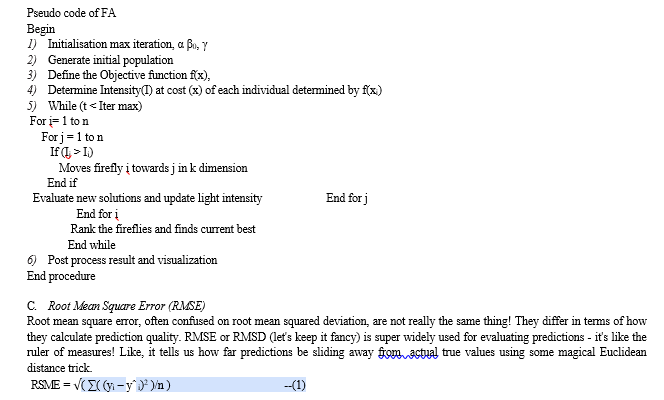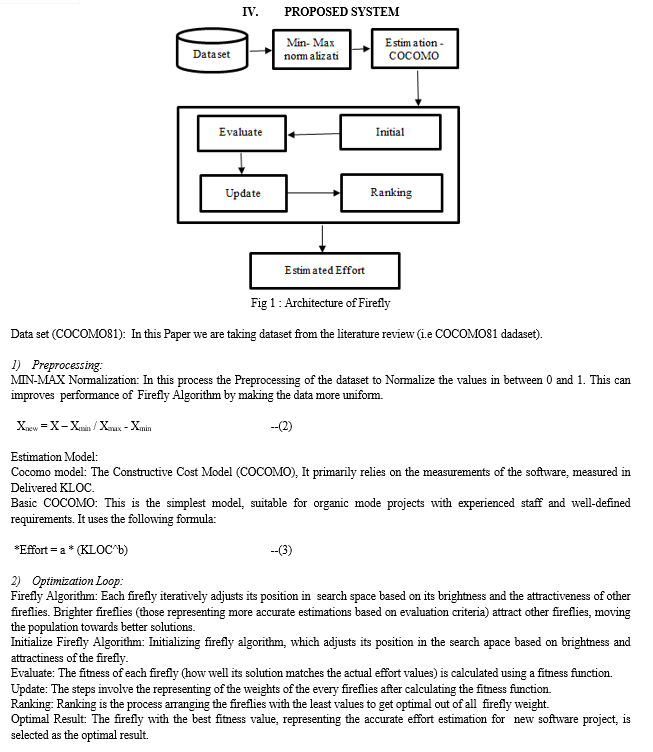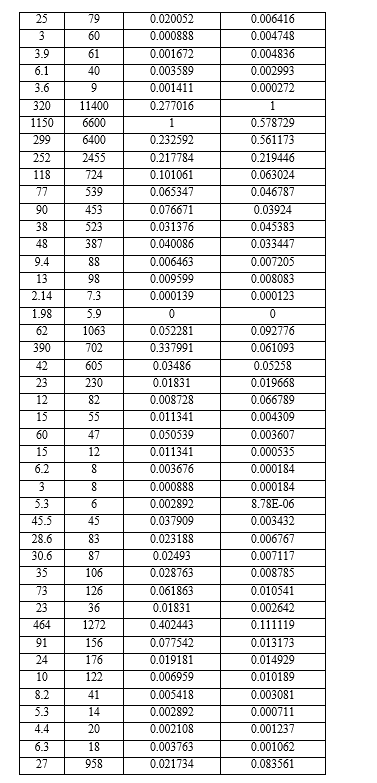Ijraset Journal For Research in Applied Science and Engineering Technology
- Home / Ijraset
- On This Page
- Abstract
- Introduction
- Conclusion
- References
- Copyright
Optimizing Software Effort Estimation Models Using Enhancement of Firefly Algorithm
Authors: B. Prabhanjali, G. Kavya, K. Suresh, V. Venkataiah
DOI Link: https://doi.org/10.22214/ijraset.2024.59309
Certificate: View Certificate
Abstract
Estimating the amount of work required in order to create software development is regarded as essential to the software development life cycle and to the control of project costs, schedules, and quality. As a result, precise estimation plays a critical role in project success and risk mitigation. Software effort estimation has drawn a lot of interest from scholars recently and presented a problem to the software business. Three COCOMO-based models\' parameters are to be optimized using a metaheuristic method called improvement of Firefly Algorithm, which is proposed in this research. The basic COCOMO model and the other two models that have suggested in literature as expansions of basic COCOMO model are among these models. Root Mean Square Error (RMSE) is one of the evaluation measures used to assess the created estimate models.
Introduction
I. INTRODUCTION
Software time and effort development of estimation models are fire topic of the study over the three decades for the engineering of software community with systematic approach to the development, maintenance and retirement of software[1]. Computer program taken a toll estimation alludes to the expectations of the probable sum of effort, time, and the number of employees required to construct a program. The essential work of the venture advancement is to guarantee that the venture is completed with the objective: "high quality of computer program must be created with a moo taken a toll that's inside time and budget"[2]. The duties of venture improvement are arranging, organizing, staffing, coordinating, and controlling the exercises. Belittling computer program costs can have an inimical effect on the quality of conveyed program and hence a company's trade reputation and competitiveness. The primary vital component of computer program extends administration is compelling preparing of the improvement of the computer program which determines the assets required to total the extend effectively. The assets incorporate the number and ability level of the individuals, and the sum of computing resources[3]. The fetched of a program venture is directly relative to the individuals / assets required for the project[5]. Overestimation of computer program fetched, on other hand, can result in missed chances to use reserves in other referential ventures. The need for solid and accurate taken a toll expectations in program building is a continuous challenge[3]. Good estimation can improves performances of the company particularly in overseeing the venture plan, human asset assignment, fetched estimation, etc. Those points of interest can decrease the disappointment possibility or extend delay. The Fetched for a extend may be a function of numerous parameters. Measure may be an essential fetched figure in most models and can be measured utilizing code snippets (or) thousands of conveyed KDLOC or work focuses. The no. of models are advanced to set up the connection between Measure and Exertion for Computer program Exertion Estimation[6]. Computer program taken a toll estimation strategies can broadly classified as algorithmic and non-algorithmic models. The algorithms-based models come from the factual examination of historical venture data, for illustration, Helpful Fetched Show (COCOMO) and Program Life Cycle Administration (SLIM)No algorithmic methods incorporate Price-to-Win, Parkinson, master judgment, machine learning approaches[7]. Machine learning is utilized to group together set of methods that embody a few of the characteristics of human intellect, for the case, foggy frameworks, similarity, regression trees, run the show acceptance neural systems, and Developmental algorithms[3]. Among the machine learning approaches, foggy frameworks and neural systems, and Developmental calculations are regarded as have a place to the delicate computing group[11]. The algorithmic as well as the non-algorithmic (based on master judgment) taken a toll estimation models, be that as it may, are not without error. A few exertion estimation model have been develops and advanced over time superior forecast precision moreover, in this way for better improvement quality. The Such model range will be from complex calculations , statistical evaluation of the project's specifications to improve machine learning approaches[10]. Heuristic optimization is plan are relies on few attempt to find the best solutions. Heuristic optimizers are have used in the software cost estimation, such as to application of the genetic programming an model optimizations.
Another case is the portion that the PSO is taken as an optimizer using heuristics. Besides, the crossover methods include the combination of heuristic algorithms just like the utilization of Hereditary Algorithm , Ant Colony[12]. In spite of an outsized number tests on finding foremost satisfactory forecast show, there's not clear prove of an extremely precise and effective strategy. At same time, it is significant to create a forecasting strategy that's fewer intricate and very extra valuable. For occasion, in few forecasting models, an outsized number of factors that are utilized to build the show don't reflect or make strides the precision of prediction show. In this way, gathering additional or disconnected factors are laborious and lacking in centrality. It could become more productive on construct a demonstrate with a least number of the variables, hopefully finding foremost vital and the common factors bland project development efforts[10].
II. BACKGROUND WORK
This here section provides an overview of some recent research which talks about the field of effort estimation for those software projects. This is actually a very active area in research and there have been lot of papers that were published recently. In this specific section, we are going to highlight and sort of review some of very important studies that kind of applied some machine learning techniques in order estimate the effort that goes to the software projects. The dynamic area that involves effort estimation for software projects, well, let's just say that recent research have actually contributed significantly to much further development of methods, especially through the uses of some ML techniques. Miltveit et al. [1], Ganesan et al. [2], and Bhattacharjee et al. [3] sort of made a pretty significant contribution by exploring this case-based approach and then proposing this model that is actually based on those expert cases. The use ML optimization algorithms has sort of become a focus on the purpose of improving that accurate of the software effort estimation, with some techniques such as Cuckoo Search and PSO, Bat Algorithm, and Firefly Algorithm gaining some traction. [3].
Shin and Goel [6] actually questioned the common use of linear regression in empirical methods and then found actually a radial basis function (RBF) neural I suggested in using the network. His proven COCOMO II model, devised by Boehm in 1981, is actually still very influential in estimating effort and development time take into accounts parameter such as effort multipliers, scaling factors, and software size [8]. A.F.Sheta [7] kind of presents this innovative model that sort of combines genetic algorithms (GA) with his COCOMO and demonstrates improved accuracy in the cost estimation. Social behavior-inspired particle swarm optimization algorithms has been sort of proven successful in variety of optimization problems and have actually demonstrated The capability for rapidly converge [9]. Additionally, continuous training of Artificial Intelligence (AI) models on data positions them as a sort of superior alternative to algorithm models inside the software cost estimation, allowing optimization of critical elements. It can sort of minimize project manpower [13]. Selecting metrics for the sizing of those software projects, including: B. Lines of code, function points and cosmic function points (CFSUs) sort of playing an important role. Cosmic FFP is characterized by use of the functional size units as a practical and kind of proven solution for size estimation and quality improvement [10]. Kara Giannopoulos et al. [11] proposed five wrapper character selection method using regression algorithms, including forward selection (FS), backward selection (BS), best first forward selection (BFFS), and best first backward selection (BFBS). By comparing, we kind of contribute to the field. Genetic Search Selection (GS) whose performance was analyzed on 12 of his UCI datasets. In domain of software cost estimation, AI techniques display superior accuracy compared to algorithmic models and iteration optimized factors to reduce the money and effort associated with software projects. As the having complexity of optimization problems increase, metaheuristic algorithms are used of particular note are genetic algorithms & Ant colony optimization (ACO) that use population-based search and evaluation. It helps to really approach the problem with an iteratively until an optimized solution is obtained with high precision!
This comprehensive background work is focusing on different approaches and innovations in software money estimation, integrating varied methods and techniques of ML, optimization algorithms, AI models, and [3] used the hybrid approach to address in-context parameter selection and models optimization. It estimating software struggle and effort. This study is focused on use genetic algorithms (GA) to optimize support vector regression (SVR) models. The authors specifically have investigated and in the impact of GA on character selection and parameter optimization, compared with other approaches, he demonstrated its effectiveness in improving on performance of SVR models. This result is highlighting the applicability of GA to improve accuracy of man power estimation models. Furthermore, a general that framework for estimate the software man power was introduced in [3].
This innovative framework aimed is to emulate human thought processes by incorporating fuzzy rule models. The generated models leveraged the expertise to ensure interoperability and applicability to different been problem areas such as risk analysis and software quality prediction.
III. EMPLOYED TECHNIQUE
A. Regression Methods
"The objective of regression methods is effectively maps a group of independent variables (X1, X2..., Xn) to the dependent variables Y; in our context, our sole goal is to construct regression models using a training dataset! Using these models will; result in predicting the total effort is required for the process of creating software projects that is measured in man-months! Extra points should be the considered for the achievement of our ultimate spelling bee success."
B. Firefly Algorithm
The Firefly Algorithm (FA) is a multimodal optimization algorithm that is inspired by the activity of fireflies and falls under the category of nature-inspired algorithms. At the University of Cambridge, Xin-She first introduced FA in 2007. It has been demonstrated through empirical evidence that FA approaches the problem more organically and could outperform other metaheuristic algorithms. FA is predicated on his three core principles. According to the first, fireflies of all genders are drawn to one another. According to the second rule, attraction is connected with luminescence or brightness, therefore brighter flies will draw in fewer brighter flies, and movement will be random in the absence of brighter flies. According to the final main rule, brightness varies with the goal function because the objective's landscape





Conclusion
The Firefly calculation seems potentially in program exertion estimation because of its capacity to optimize parameters and managing complex, non-linear connections within datasets. Its iterative nature permits for continuously advancements and adjustment, possibly leading to more accurate estimations over time. However, encouraging investigate and approvals are essential to fully evaluate its adequacy and comparing it with the existing estimation strategies.
References
[1] Zareei, M. and Hassan-Pour, H.A., 2015. A multi- objective resource-constrained optimization of time-cost trade-off problems in scheduling project. Iranian Journal of Management Studies, 8(4). [2] Ranichandra, S., 2020. Optimizing non?orthogonal space distance using ACO in software cost estimation. Mukt Shabd J, 9(4), pp.1592-1604 [3] Ghatasheh, N., Faris, H., Aljarah, 2019. Optimizing software cost estimation models using firefly algorithm. arXiv preprint arXiv:1903.02079. [4] Ahadi, M. and Jafarian, A., 2016. A new hybrid for software effort estimation using particle swarm optimization and differential evolution algorithms. Informatics Engineering, an International Journal (IEIJ), 4(1). [5] Dizaji, Z.A. and Khalilpour, K., 2014. APPARATUS BASED ON CHAOS THEORY AND PARTICLE SWARM OPTIMIZATION FOR SOFTWARE COST ESTIMATION. International Journal of Academic Research, 6(3). [6] Braga, P.L., Oliveira, A.L. and Meira, S.R., 2007, September. estimating software effort with solid confidence intervals with machine learning algorithms. During the 7th International Conference on Hybrid Intelligent Systems (HIS 2007) (pp. 352-357). IEEE. [7] Dizaji, Z.A., Ahmadi, R., Gholizadeh, H. and Gharehchopogh, F.S., 2014. A software cost estimating method using a bee colony optimization algorithm. International Journal of Computer Applications, 104(12). [8] Puspaningrum, A. and Sarno, R., 2017 A software cost estimating technique combining harmony search and cuckoo optimization. Procedia Computer Science, 124, pp.461-469. [9] Wu, D., Li, J. and Bao, C., 2018. Software effort estimation using case-based reasoning and optimum weight obtained from particle swarm optimization. Soft Computing,22, pp.5299-5310. [10] Li, Y.F., Xie, M. and Goh, T.N., 2009. An analysis of feature weighting and project selection for analogy-based software cost estimating. Journal of systems and software, 82(2), pp.241-252. [11] Harou, J.J., Pulido-Velazquez, M., Rosenberg, D.E., Medellín-Azuara, J., Lund, J.R. and Howitt, R.E., 2009. Hydro-economic models: Concepts, design, applications, and future prospects. Journal of Hydrology, 375(3-4), pp.627-643. [12] Adamu, A., Abdullahi, M., Junaidu, S.B. and Hassan, I.H., 2021. A hybrid particle swarm optimization method for feature selection that combines the crow search technique. Machine Learning with Applications, 6, p.100108.
Copyright
Copyright © 2024 B. Prabhanjali, G. Kavya, K. Suresh, V. Venkataiah . This is an open access article distributed under the Creative Commons Attribution License, which permits unrestricted use, distribution, and reproduction in any medium, provided the original work is properly cited.

Download Paper
Paper Id : IJRASET59309
Publish Date : 2024-03-22
ISSN : 2321-9653
Publisher Name : IJRASET
DOI Link : Click Here
 Submit Paper Online
Submit Paper Online

